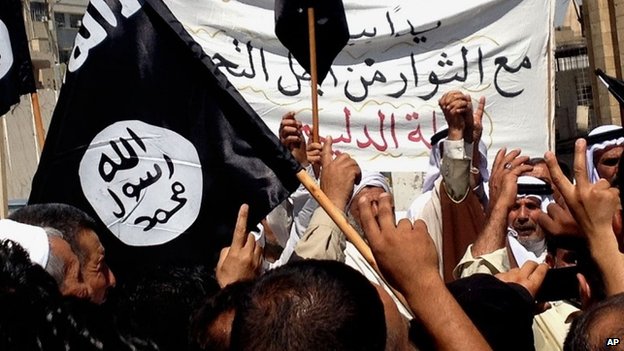What is Islamic State?

BBC Online
Islamic State (IS) is a radical Islamist group that has seized large swathes of territory in eastern Syria and across northern and western Iraq.
Its brutal tactics - including mass killings and abductions of members of religious and ethnic minorities, as well as the beheadings of soldiers and journalists - have sparked fear and outrage across the world and prompted US military intervention.
What does IS want?
The group aims to establish a "caliphate", a state ruled by a single political and religious leader according to Islamic law, or Sharia.

Although currently limited to Iraq and Syria, IS has promised to "break the borders" of Jordan and Lebanon and to "free Palestine". It attracts support from Muslims across the world and demands that all swear allegiance to its leader - Ibrahim Awad Ibrahim Ali al-Badri al-Samarrai, better known as Abu Bakr al-Baghdadi.
Abu Bakr al-Baghdadi: Islamic State's driving force
Isis: A thoroughly modern caliphate

What are its origins?
IS can trace its roots back to the late Abu Musab al-Zarqawi, a Jordanian who set up Tawhid wa al-Jihad in 2002. A year after the US-led invasion of Iraq, Zarqawi pledged allegiance to Osama Bin Laden and formed al-Qaeda in Iraq (AQI), which became a major force in the insurgency.
After Zarqawi's death in 2006, AQI created an umbrella organisation, Islamic State in Iraq (ISI). ISI was steadily weakened by the US troop surge and the creation of Sahwa (Awakening) councils by Sunni Arab tribesmen who rejected its brutality. After becoming leader in 2010, Baghdadi rebuilt ISI's capabilities. By 2013, it was once again carrying out dozens of attacks a month in Iraq. It had also joined the rebellion against President Bashar al-Assad in Syria, setting up the al-Nusra Front.
In April 2013, Baghdadi announced the merger of his forces in Iraq and Syria and the creation of the Islamic State in Iraq and the Levant (Isis). The leaders of al-Nusra and al-Qaeda rejected the move, but fighters loyal to Baghdadi split from al-Nusra and helped Isis remain in Syria.

At the end of December 2013, Isis shifted its focus back to Iraq and exploited a political stand-off between the Shia-led government and the minority Sunni Arab community. Aided by tribesmen, the group took control of the central city of Falluja.

In June 2014, Isis overran the northern city of Mosul, and then advanced southwards towards Baghdad. At the end of the month, after consolidating its hold over dozens of cities and towns, Isis declared the creation of a caliphate and changed its name to Islamic State.
How much territory does IS control?
Some estimate that IS and its allies control about 40,000 sq km (15,000 sq miles) of Iraq and Syria - roughly the size of Belgium. Others believe they control closer to 90,000 sq km (35,000 sq miles) - about the size of Jordan. That territory includes cities - Mosul, Tikrit, Falluja and Tal Afar in Iraq; Raqqa in Syria - oil fields, dams, main roads and border crossings.
Eight million people are believed to be living under partial or full IS control, where the group implements a strict interpretation of Sharia, forcing women to wear veils, non-Muslims to pay a special tax or convert, and imposing punishments that include floggings and executions.

How many fighters does it have?

US officials believe IS could have as many as 31,000 fighters in Iraq and Syria. Iraq expert Hisham al-Hashimi says about 30% are "ideologues", with the remainder joining out of fear or coercion.
A significant number of IS fighters are neither Iraqi nor Syrian. The Soufan Group recently estimated that more than 12,000 foreign nationals from at least 81 countries, including 2,500 from Western states, had travelled to Syria to fight over the past three years.
What weapons does IS have?
IS fighters have access to, and are capable of using, a wide variety of small arms and heavy weapons, including truck-mounted machine-guns, rocket launchers, anti-aircraft guns and portable surface-to-air missile systems. They have also captured tanks and armoured vehicles from the Syrian and Iraqi armies. Their haul of vehicles from the Iraqi army includes Humvees and bomb-proof trucks that were originally manufactured for the US military.

The group is believed to have a flexible supply chain that ensures a constant supply of ammunition and small arms for its fighters. Their considerable firepower helped them overrun Kurdish Peshmerga positions in northern Iraq in August, surprising many.
Where does IS get its money from?
Islamic State is reported to have $2bn (£1.2bn) in cash and assets, making it the world's wealthiest militant group. Initially, much of its financial support came from individuals in Arab Gulf states.

Today, IS is a largely self-financed organisation, earning millions of dollars a month from the oil and gas fields it controls, as well as from taxation, tolls, smuggling, extortion and kidnapping. The offensive in Iraq has also been lucrative, giving it access to cash held in major banks in cities and towns it has seized.
Islamic State: Who supports the jihadist group?
Why are their tactics so brutal?

IS members are jihadists who adhere to an extreme interpretation of Sunni Islam and consider themselves the only true believers. They hold that the rest of the world is made up of unbelievers who seek to destroy Islam, justifying attacks against other Muslims and non-Muslims alike.
Beheadings, crucifixions and mass shootings have been used to terrorise their enemies. IS members have justified such atrocities by citing the Koranic verses that talk of "striking off the heads" of unbelievers, but Muslims have denounced them. Even al-Qaeda leader Ayman al-Zawahiri, who disavowed IS in February over its actions in Syria, warned Zarqawi in 2005 that such brutality loses "Muslim hearts and minds".


 For all latest news, follow The Daily Star's Google News channel.
For all latest news, follow The Daily Star's Google News channel. 



Comments